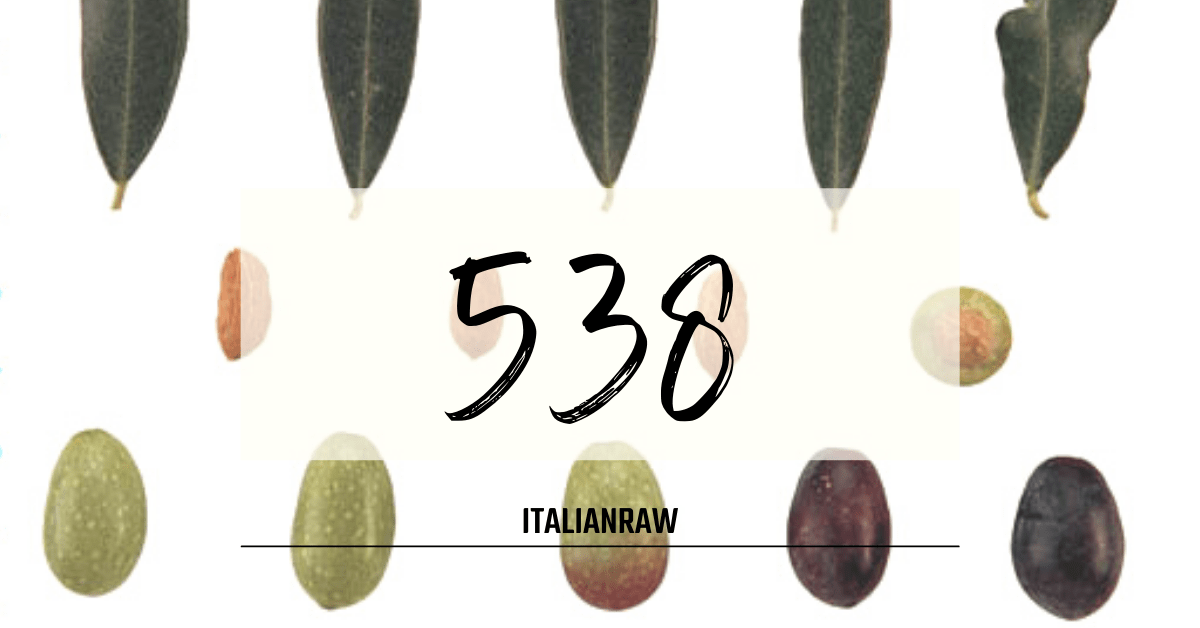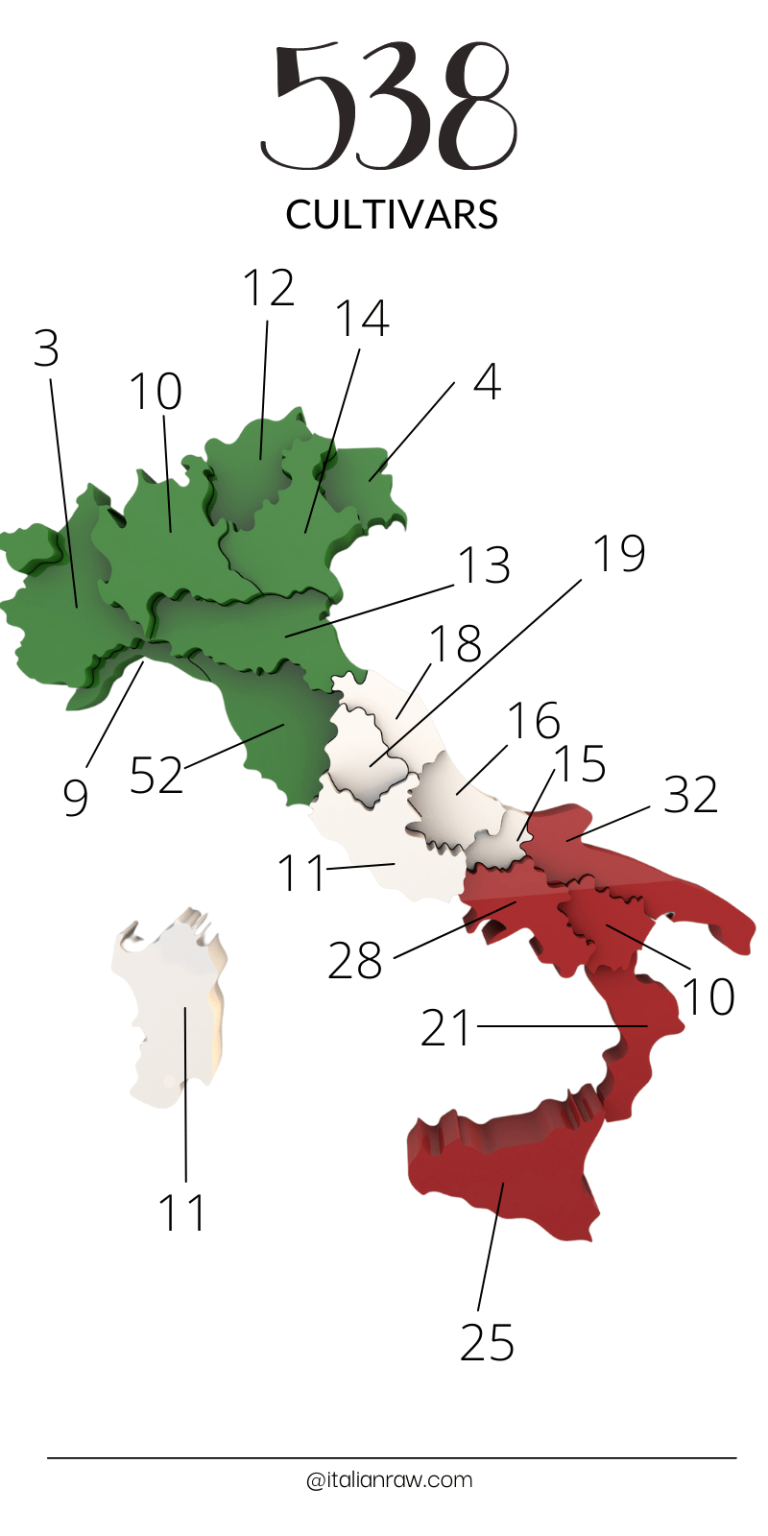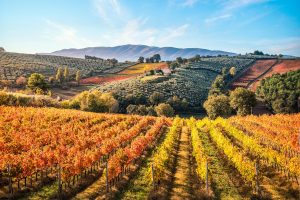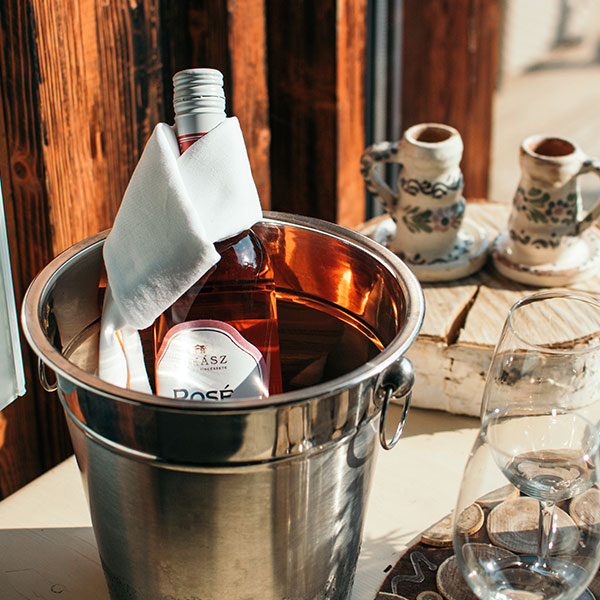
HOW MANY VARIETIES OF OLIVE TREES EXIST IN ITALY?
The biodiversity of extra virgin olive reaches a world record in Italy, with a whopping 538 different varieties of olive trees.
There’s an authentic agricultural feature capable of uniting Italy as it was in the ancient world with the Italy of the 21st century: this uniqueness is undoubtedly represented by the olive tree.
The biodiversity of this plant is hugely impressive.
There are 538 Italian olive cultivars, of which 250 are cultivated regularly.
There are around 250 million trees, many of which are centuries old: 450 thousand tons of oil are produced by these every year alone.
There’s almost one olive tree for each Italian living in the country in Apulia alone.
CULTIVARS OF OLIVE TREES IN ITALY: The Main Cultivars for each Region

ITALY IS THE COUNTRY OF BIODIVERSITY AND HERE IS WHY
In recent years there’s been much talk about the importance and need for biodiversity = Biological + Diversity.
In recent years, there’s been much talk about the importance and need for biodiversity, which accounts for biological diversity.
Italy’s edible vascular flora comprises of 7,634 vascular species.
Italy is one of the most diverse European countries by the number of vegetable species: half of Europe’s vegetable species live in Italy. Every single Italian region hosts, on average, more vegetable species than the majority of other European countries.
If we were asked to find just one product to represent Italy… there could be only one answer: the humble olive tree.
WHERE ARE THE OLIVE TREES LOCATED IN ITALY?

The plains that extend from Salento to Basilicata look much like a Scottish tartan blanket; meanwhile, regions such as Sicily, Sardinia, and Calabria boast the majority of their cultivation among the hills and valleys.
There’s a similar olive-growing panorama in Campania, Abruzzo, and Molise, where latitude and altitude make frost and snow more likely to change the landscape that falls before the eyes.

Moving to the north of Umbria, Lazio, and Tuscany, woods and vines alternate with the olive groves. But this landscape becomes less intense in Emilia Romagna and on the great Po Plain. The landscape diversifies once again up north, along the coastal region of Liguria. There, millions of terraces rest, supported by dry stone walls, the Ligurian olive oil trees grow against odds in the most asperous challenging slopes.
The olive trees of the Friuli and Veneto, on the northeast side, look towards the Adriatic.
This resistant and generous tree has survived on the perilous slopes of Monviso and the very steep inclines of Arnad in Piedmont; however, it has never left Lombardy or Trentino, home of the lakes, where it decorates a landscape that delights the eye with the gentleness of its hills.

Italy’s most common cultivars are:
Bosana, Canino, Carboncella, Casaliva, Coratina, Frantoio, Leccino, Moraiolo, Pendolino, Taggiasca.
Main Cultivar of the North of Italy
- Lombardia: Casaliva, Grignano, Gargnà, Favarol
- Veneto: Casaliva, Grignan, Favarol, Perlarol, Trepp
- Trentino: Casaliva, Raza, Favarol
- Friuli: Bianchera
- Liguria: Taggiasca, Razzola, Pignola, Rossese, Colombaia
Main Cultivar of the Center of Italy
- Emilia Romagna: Correggiolo, Nostrana di Brisighella, Ghiacciolo
- Toscana: Frantoio, Moraiolo, Leccino, Maurino, Pendolino, Maurino, Olivastra Seggianese
- Marche: Ascolana, Carboncella, Canino, Mignola, Rosciola
- Umbria: Borgiona, Bianchella di Umbertide, Correggiolo, Dolce Agogia, Raia, Moraiolo, Frantoio, Leccino, San Felice.
- Lazio: Caninese, Itrana, Raia, Carboncella
- Abruzzo: Dritta, Gentile di Chieti, Tortiglione, Intosso, Cucco, Nebbio, Castiglionese, Rustica
- Molise: Aurina di Venafro, Cazzarella, Cellina di Rotello, Gentile di Larino, Oliva di Colletorto, Sperone di Gallo
Main Cultivar of the South of Italy
- Puglia: Cima di Bitonto / di Mola, Cellina di Nardò, Coratina, Ogliarola Barese / Salentina, Peranzana Provenzale, Pizzuta di Massafra
- Campania: Asprinia, Biancolella, Carpellese, Minucciola, Ortice, Ortolana, Pisciottana, Racioppella, Ravece, Rotondella, Tonda
- Basilicata: Ogliarola, Coratina, Maiatica
- Calabria: Carolea, Sinopolese, Grossa di Gerace, Cassanese, Ottobratica
Main Cultivar from Sicily and Sardinia
- Sicilia: Cerasuola, Biancolilla, Nocellara del Belice, Nocellara Etnea, Tonda Iblea, Ogliarola Messinese
- Sardegna: Bosana, Semidana, Nera di Villacidro, Pizz e Carroga, Tonda di Caglia
2 Comments
-
-
angela
Hello Lori, we picked the most important varieties of olives but I’ll surely search for “Nostrana” variety and update the post. Thank you for pointing that out!!! Angela Italianraw Team
-










Lori
We live in the Basilicata region and have a small olive grove of nostrana. No mention of these. I wonder why? The area claims they are a good olive. Any info?